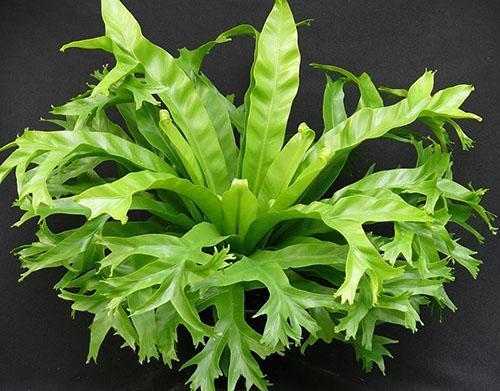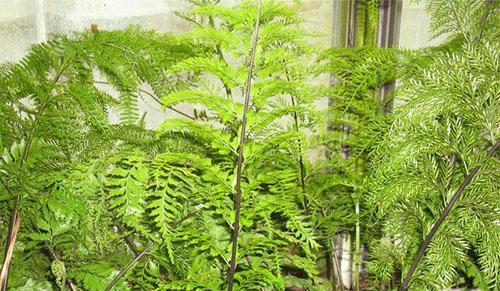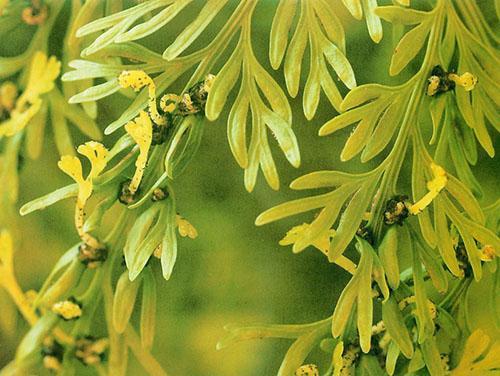Features of home care for asplenium
 For many reasons, ferns have become very popular in indoor gardening. The green color is soothing, the carved fronds are picturesque and eye-catching, taking thoughts away from negativity. There are 800 species of ancient ferns. Asplenium is a type of tropical plant, many of which are epiphytes, growing in symbiosis with and on trees. Three varieties of asplenium have been identified in the culture, care for which is available at home and in greenhouses.
For many reasons, ferns have become very popular in indoor gardening. The green color is soothing, the carved fronds are picturesque and eye-catching, taking thoughts away from negativity. There are 800 species of ancient ferns. Asplenium is a type of tropical plant, many of which are epiphytes, growing in symbiosis with and on trees. Three varieties of asplenium have been identified in the culture, care for which is available at home and in greenhouses.
Asplenium agrotechnics

- correct illumination;
- sufficient air humidity;
- air exchange without drafts;
- temperature conditions in summer and winter;
- watering, fertilizer and soil requirement.
If, having given birth to a child, we raise him, and over time he can do without help, then the houseplant will always be helpless, demanding care and attention. It will only benefit from its presence with careful care. A green window sill with diseased plants will not create a comfortable state.
 When creating a home garden, it is necessary to find a place for each plant to taste. Asplenium in lighting does not like direct sunlight. And if the apartment does not have northern windows, then it should be placed at a depth of at least 3 m from the window. We know that healthy leaves absorb harmful substances from the air, thereby purifying it. Therefore, it is so important to have healthy fronds. In a dark corner, the flower will stop growing and developing. In the light, the leaf plates will turn pale. Only a golden mean in the care and maintenance of asplenium will lead to success!
When creating a home garden, it is necessary to find a place for each plant to taste. Asplenium in lighting does not like direct sunlight. And if the apartment does not have northern windows, then it should be placed at a depth of at least 3 m from the window. We know that healthy leaves absorb harmful substances from the air, thereby purifying it. Therefore, it is so important to have healthy fronds. In a dark corner, the flower will stop growing and developing. In the light, the leaf plates will turn pale. Only a golden mean in the care and maintenance of asplenium will lead to success!
There are special techniques to obtain the required air humidity for a plant. The ideal humidity is 60%, it is a comfortable environment for humans. It is impossible to create such conditions in apartments with central heating. Local humidification must be used.
Asplenium care technology requires frequent spraying of the sheets with a fine spray. Even in winter, this wetting should be done 2 times a day. In summer, the leaves are moistened more often, and the number of approaches depends on the ambient temperature. Constant evaporation should be organized nearby. It is achieved by an evaporator, diapers on heating batteries or a pallet installed nearby with porous moistened materials - moss, expanded clay. When spraying, you need to use only settled soft warm water, you can use boiled water.
 In a cool room, excess moisture in the asplenium in winter can lead to mold. Unlike other ornamental plants, ferns love showers, but protect their fronds from touch. So it is better not to touch them again and not to stress the plant. The consequences of insufficient moisture will be drying of the leaves, discoloration and the appearance of aphids. Aphids will be indicated by the brown color of the leaf blade. The fern aphid does not curl the leaves.
In a cool room, excess moisture in the asplenium in winter can lead to mold. Unlike other ornamental plants, ferns love showers, but protect their fronds from touch. So it is better not to touch them again and not to stress the plant. The consequences of insufficient moisture will be drying of the leaves, discoloration and the appearance of aphids. Aphids will be indicated by the brown color of the leaf blade. The fern aphid does not curl the leaves.
 Asplenium loves watering sparingly, without a bay. A clod of earth should only be damp. Even in summer they water it 2-3 times a week, in winter as required. But before fertilization, be sure to moisten the soil.Fertilize the plant during the growing season once every 2 weeks with a special composition for ferns. It contains more organic extract and few mineral salts. Fertilizer is suitable for ficuses, but in half the dose. Excessive soil salinization will lead to the death of the plant. Water for irrigation is taken demineralized, or naturally soft with a small amount of carbonates.
Asplenium loves watering sparingly, without a bay. A clod of earth should only be damp. Even in summer they water it 2-3 times a week, in winter as required. But before fertilization, be sure to moisten the soil.Fertilize the plant during the growing season once every 2 weeks with a special composition for ferns. It contains more organic extract and few mineral salts. Fertilizer is suitable for ficuses, but in half the dose. Excessive soil salinization will lead to the death of the plant. Water for irrigation is taken demineralized, or naturally soft with a small amount of carbonates.
The best watering method is bottom watering, while the plant with the pot is lowered into a container and waited for the clod to be completely saturated with moisture. The field is created for several hours to filter excess liquid. Overflow and drought are equally damaging to the plant.
 Of great importance in the care of Asplenium is clean air without drafts. Like other plants of this species, Asplenium cannot stand the tobacco smoke of the room. Drafts are also contraindicated for kostenets fern. There is only one reaction to the wrong conditions of detention - drying of the leaves. In this case, the plant can be freed from dried plates and create constant air humidity. After a while, the leaves will begin to grow again. It is not recommended to cut off healthy leaves just like that.
Of great importance in the care of Asplenium is clean air without drafts. Like other plants of this species, Asplenium cannot stand the tobacco smoke of the room. Drafts are also contraindicated for kostenets fern. There is only one reaction to the wrong conditions of detention - drying of the leaves. In this case, the plant can be freed from dried plates and create constant air humidity. After a while, the leaves will begin to grow again. It is not recommended to cut off healthy leaves just like that.
Kostenets are rarely transplanted when the need arises:
- the growth of new leaves stops;
- fronds begin to turn yellow;
- there is an intensive drying of the foliage, subject to the conditions of detention;
- the container is tightly filled with roots.
 The soil for asplenium is compiled in equal proportions peat, leaf and sod land, sand. Chopped sphagnum and charcoal will be useful additives. When transplanting, choose a larger pot size, but not spacious. Until the roots fill the ground, the aboveground part of the plant will not develop. Young plants are transplanted annually; for adults, the dishes are changed if necessary. At the same time, a healthy plant is passed over the coma without destruction and the substrate is not compacted.
The soil for asplenium is compiled in equal proportions peat, leaf and sod land, sand. Chopped sphagnum and charcoal will be useful additives. When transplanting, choose a larger pot size, but not spacious. Until the roots fill the ground, the aboveground part of the plant will not develop. Young plants are transplanted annually; for adults, the dishes are changed if necessary. At the same time, a healthy plant is passed over the coma without destruction and the substrate is not compacted.
Diseased roots must be removed and the wounds disinfected. It is necessary to transplant the diseased plant after cleaning into a smaller pot so that there is no acidification of the earth.
Diseases and pests
 Asplenium care consists in constant monitoring of the condition of the plant. Despite the special composition of the juice of fern species, pests and diseases can invade a weakened plant. So, excessive watering can cause septoria, gray rot. Spots can be a signal that the plant is overfeeding. Such spots are the result of taphina or phyllosticta diseases. Treatment of fungal spore-bearing diseases is carried out with fungicides. During treatment, watering is reduced and top dressing is excluded.
Asplenium care consists in constant monitoring of the condition of the plant. Despite the special composition of the juice of fern species, pests and diseases can invade a weakened plant. So, excessive watering can cause septoria, gray rot. Spots can be a signal that the plant is overfeeding. Such spots are the result of taphina or phyllosticta diseases. Treatment of fungal spore-bearing diseases is carried out with fungicides. During treatment, watering is reduced and top dressing is excluded.
 Plants in dry air attack aphids and scale insects. You can save yourself from them with insecticides or folk methods. But if nematodes are bred in the fronds, then such a plant is difficult to cure, it is better to get rid of it so as not to infect all the other plants. You can find nematodes if you moisten a leaf with brown inner spots and put it on dark paper. Small, up to 1 mm worms, visible on a black background, will begin to emerge from the plate. You can pick such fronds, stop watering and spraying the plant for a while, in some cases it helps.
Plants in dry air attack aphids and scale insects. You can save yourself from them with insecticides or folk methods. But if nematodes are bred in the fronds, then such a plant is difficult to cure, it is better to get rid of it so as not to infect all the other plants. You can find nematodes if you moisten a leaf with brown inner spots and put it on dark paper. Small, up to 1 mm worms, visible on a black background, will begin to emerge from the plate. You can pick such fronds, stop watering and spraying the plant for a while, in some cases it helps.
Recommended varieties for indoor breeding
 In conclusion, we will name the most suitable varieties of Asplenium for maintenance and care at home. Asplenium nesting is the most widespread plant in culture. The fern is epiphytic, has large leaves up to a meter, which grow from the center, creating a funnel. This plant needs space, it is actively growing in width. It was named nest-like for the peculiar placement of creeping roots and leaves.
In conclusion, we will name the most suitable varieties of Asplenium for maintenance and care at home. Asplenium nesting is the most widespread plant in culture. The fern is epiphytic, has large leaves up to a meter, which grow from the center, creating a funnel. This plant needs space, it is actively growing in width. It was named nest-like for the peculiar placement of creeping roots and leaves.
 Asplenium bulbiferous has feathery leaves, grows very quickly, leaves are strongly dissected, hanging down. Small plants develop on the adventitious buds, which fall into the ground and take root.
Asplenium bulbiferous has feathery leaves, grows very quickly, leaves are strongly dissected, hanging down. Small plants develop on the adventitious buds, which fall into the ground and take root.
 Asplenium anticum, or osaka, is less common. It has feathery leaves that are wavy at the edges.
Asplenium anticum, or osaka, is less common. It has feathery leaves that are wavy at the edges.